How to Teach Yourself Guitar? – 8 Steps to Success

Learning a guitar by yourself is rewarding and challenging. You get to do something out of the box and outside your comfort zone. This proved why 52% of electric guitar players called themselves self-taught players over the years.
We want to write about it because we understand how overwhelming it can be to start learning guitar. Either you don’t find the right instructor or have the correct materials.
If that’s what you are facing, read on.
How to Teach Yourself Guitar
- Purchasing beginner-friendly guitar and essential tools
- Learning basic chords and strumming pattern
- Understanding guitar tabs and music sheets
- Learning the first song
- Paying attention to the rhythm and timing
- Overcoming common challenges
- Finding online learning resources and materials
- Seeking help from a professional if needed
Why is Learning Guitar on Your Own Achievable?
The Rise of Self-Teaching Methods
When the pandemic hit, people spent a lot of time at home. They had nothing else to do, so they started learning new instruments. You would be surprised to learn that over 77% of them began playing and practicing during that time.
It was easy then because the Internet had so many self-guided learning materials; no one had to think about going anywhere. This was the start when guitar enthusiasts thought, why not teach guitar by themselves? The sole reason was:
- Affordable guitars
- Flexibility
- Control over the learning process
- Learning at own home and schedule
- Customizable learning sessions
- Zero cost of lessons or transportation
Advantages of Teaching Yourself Guitar
The only reason is to learn at your own pace.
Most of the time, we hear from the students how they find it difficult to attend a class where everything happens clockwise. They feel pressured or stressed about how others are doing in class. For some, the schedule doesn’t match their timetable, so they eventually stop attending the practice sessions.
But with self-learning sessions, you take the time to finish the guitar lessons individually.
Besides, you are getting:
- Flexible schedule to learn comfortably
- The lesson session as per your liking
- Can pick any style of music, techniques, or songs
- Self-discipline and problem-solving skills.
- An enjoyable and rewarding experience
Getting Started: What You Need Before You Begin
You will need a guitar if you want to learn guitar.
We know that’s obvious, but if you are new, let’s get to see the guitar a bit more; if not, stick with us.
Choosing the Right Guitar for Beginners
First, Acoustic guitar Vs. Electric guitar
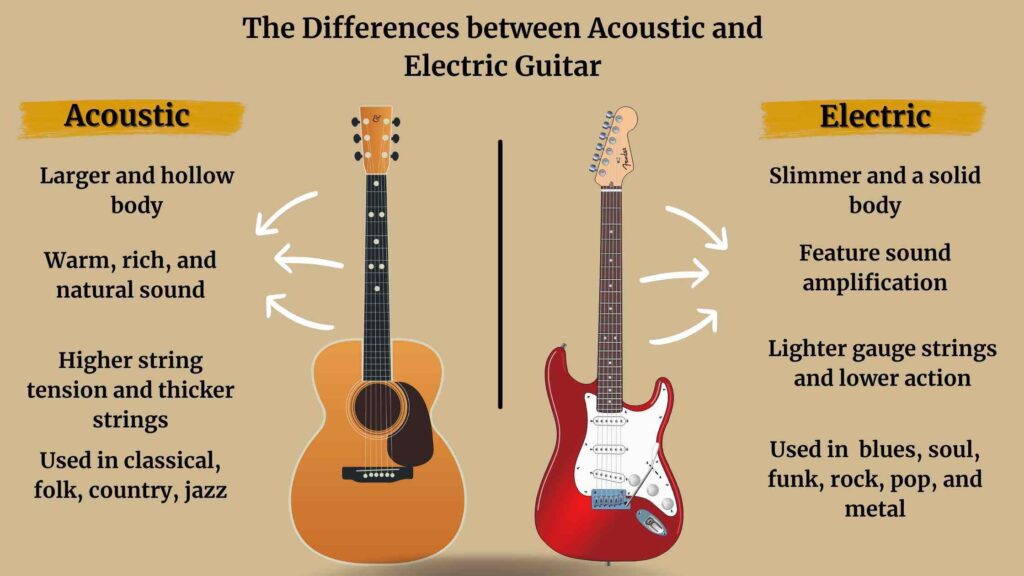
Second, guitar sizes and shapes
Third, essential tools and accessories for self-taught guitarists
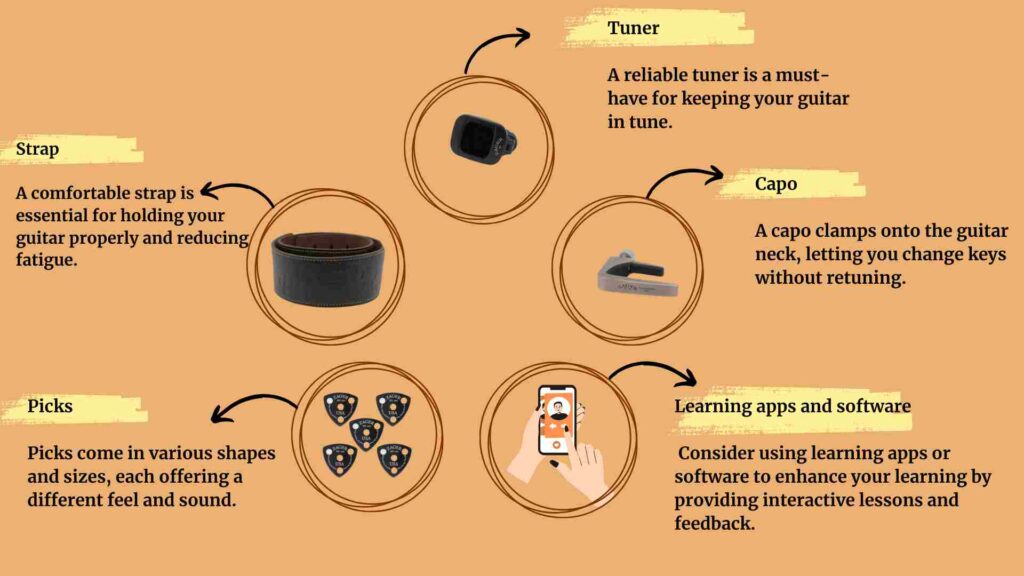
Buy any tools from Zager at an affordable price range.
Developing Your Learning Plan: What to Focus on First
Okay, we are done with our brief introduction to guitar. Let’s move on to the learning part.
Learning Basic Chords and Strumming Patterns
The word basic eliminates the difficulty. Your target isn’t learning the advanced chords; you will start with something simpler and easiest to learn. As a result, you won’t fall out because the chords were too tricky. Follow these steps to know how to go smoother in the first go:
- Step 1: Focus on essential chords. In guitar language, beginning with chords like C, G, D, E, and A. These five chords are basically the foundation for countless songs.
- Step 2: Draw or download a picture of a chord diagram. Use it as a visual aid to familiarize yourself with each finger’s position for each chord.
- Step 3: There is no hurry. Begin by slowly moving between two chords, like C to G, so that the accuracy is on point.
- Step 4: Next, gradually increase your speed. Go for a smooth flow without pausing.
- Step 5: Consider getting a metronome. This tool will help you develop a sense of timing and confidence.
Simple Strumming Techniques for Beginners
After learning where to place the fingers or press the chords, get into the strumming. The same rules go here as well, starting with basic strumming techniques.
Don’t aim for variations like muted strings or rhythmic patterns.
What you will learn is:
| Downstrokes | This involves strumming all the strings downward. It is very simple to learn but necessary. Start from the high E string and move to the low E strings. | Now, combine both of these to create different rhythms. For example, you could strum “down-up-down-up” to create a simple beat. |
| Upstroke | This one is when you go upwards. It’s the same as downstrokes but starts from the low E strings and gradually goes up. |
Practicing Finger Exercises and Dexterity Training
Another essential thing to note is that guitar playing isn’t just about strumming or picking. You also need to have the flexibility to play for longer periods. To prevent finger fatigue, it’s important to do warm-up exercises to keep your fingers and hand movements comfortable during each session. Try these simple exercises to improve muscle health and memory:
| Exercise | How to do | Benefits |
| Chromatic Scale | Play each fret in sequence from the 1st to the 4th on each string. Keep all the notes ringing clearly, and fingers be curved and close to the fretboard. | It will help you use your finger on the frets comfortably, |
| Finger Stretching | It’s the same as chromatic, but you can do something different here by practicing the skip string. For example, you could play the 1st fret on the low E, then the 2nd fret of the D string. | This one will enhance your flexibility and reach. |
| Spider | Here, you will start with the 1st fret of the High E string and gradually go down. Lift each finger one at a time, then place it back down. | It will give you both finger flexibility and control. |
Read more about Guitar Finger Exercises: Build Strength, Speed, & Dexterity.
Understanding Guitar Tabs and Sheet Music
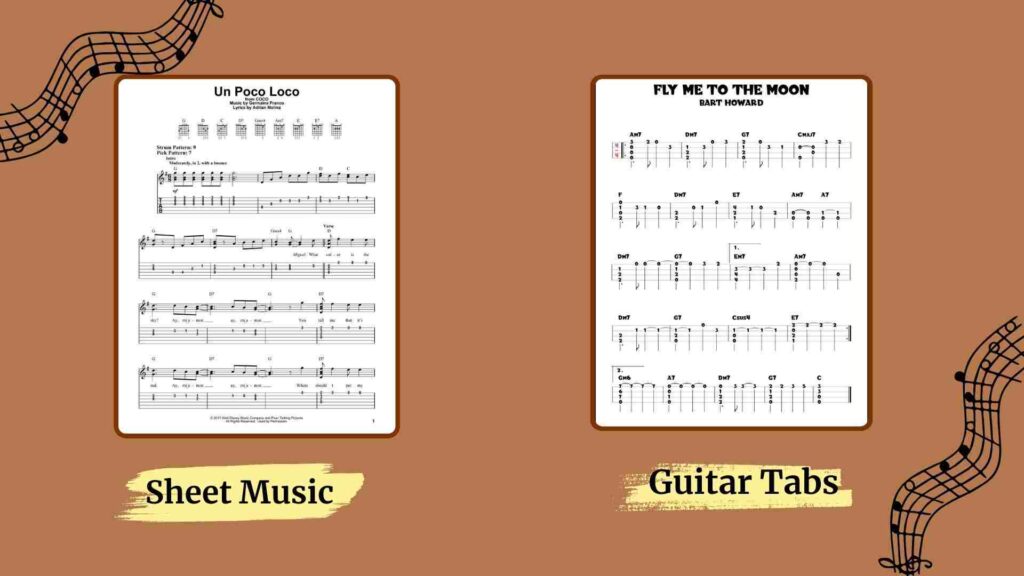
Are you done with chords and strum? Moving on, we have guitar tabs and sheet music. These are great ways to learn new songs.
Don’t know what guitar tabs and sheet music are? So, tabs represent the fretboard, while sheet music uses musical notation.
Here is the breakdown for easy understanding:
| Guitar Tab | Sheet Music | |
| Format | Uses six or four horizontal lines to represent the strings. | Uses staff made up of five lines and four spaces to indicate musical notes. |
| Learning Songs | Easy to learn songs and enjoyable practice sessions. | Understanding of how songs are composed and arranged. |
| Developing Skills | Help with finger placement and hand coordination | Enhances reading skills and ear training. |
| Versatility in Playing | Go well with rock and pop music. | Essential for classical and jazz music. |
| Improvisation and Compositions | Inspire creativity by showing how to play riffs and solos. | Provides a framework for writing a song |
| Player level | Easier for beginners to read. | Expert players understand the notation the most. |
Zager offers over 1700 fully illustrated, easy-to-learn options if you’re searching for guitar tabs online. It has free step-by-step instructions for popular songs. Check out the Free Guitar Tabs.
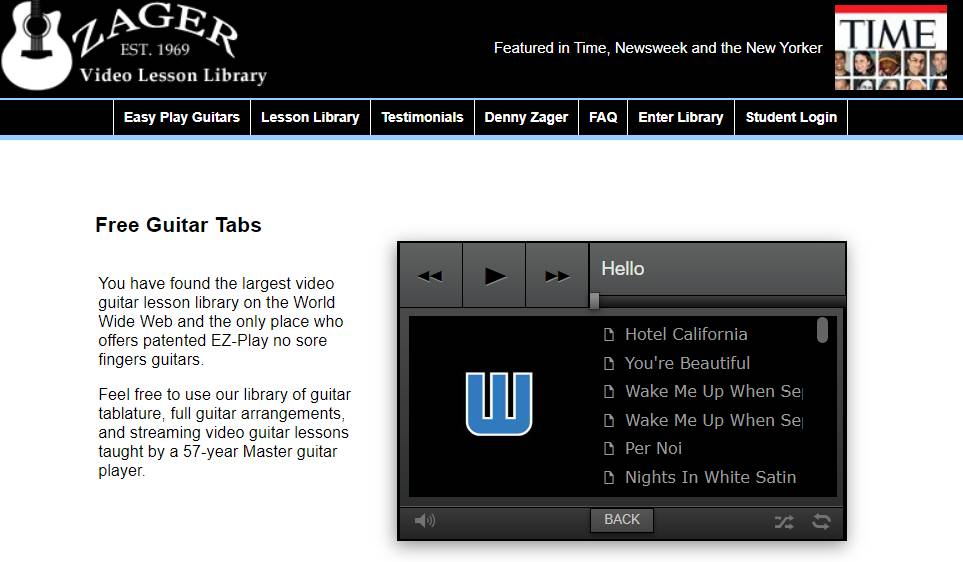
Building Your Skills: Techniques to Improve Fast
Here comes the fun part. It’s fun because you can learn to play your favorite songs on the guitar. This was the day you learned the chords, strumming, tabs, and other guitar techniques. Since we are simplifying each segment for you, we will also cut the song-making section into bits.
Learn Your First Song
Step 1: Look for songs that use basic chords and straightforward strumming patterns, for example, in “Three Little Birds” by Bob Marley.
Step 2: Run down the website or YouTube to gather resources to find the beginner-friendly songs list.
Step 3: Listen to the song. Familiarize yourself with the melody and rhythm.
Step 4: Start by learning the chords used in the song and practicing.
Step 5: Break the song into verse, chorus, and bridge. Focus on one section at a time.
Step 6: Use a metronome or play along with a slower version of the songs to improve accuracy.
Step 7: Practice each strumming pattern separately and combine them once you feel comfortable.
Step 8: After completing all the sections, try playing along with the recording. Put concentration on staying on time and maintaining a steady rhythm.
Rhythm and Timing: Why It’s Important
In step 8 of learning a song, we have highlighted the importance of staying on time and maintaining a steady rhythm. This is essential for good guitar playing as it helps you keep a steady tempo and play in sync. How can you do it? This is how:
- Use a Metronome
- Set the metronome at a slow tempo and increase it as you gain confidence.
- Practice playing with the metronome.
- Be consistent with the practice, especially when working on chord transitions and strumming patterns.
- Techniques to improve rhythm and timing
- Doing clapping exercises to internalize the rhythm before you play. Start with the basic quarter notes, then progress to 8th notes and triplets.
- Foot taping is another way to steady tempo and reinforce your sense of timing.
- Playing with the backing tracks to emphasize rhythm.
- You can try different strumming patterns and rhythms. It will give variety to your playing.
Overcoming Common Challenges When Learning Guitar
Any skill requires time and patience. Nothing comes easy, and you will face challenges along the way. However, we don’t want you to give up. That’s why here are some common challenges you might encounter and solutions to help you overcome them.
| Challenges | Description | Solution |
| Finger pain | Uneasiness when pressing down on strings. | Take a break in between playing sessions for 15 to 20 minutes. Place your finger properly with techniques. Check if your guitar is correctly set up or not. |
| Fatigue during practice | Worn-out fingers from the tiredness | Increase the practice duration step by step. Switch between hard and easy exercise. Keep your hand relaxed to prevent tension. |
| Blisters | Skin irritation from repetitive motion | Build up practice time slowly to toughen the skin. Try using a lighter gauge initially. You can use finger pads for extra protection. |
| Cramping | Muscle cramps in fingers or hands | Do warm-ups or stretches before playing. Don’t squeeze your grip too hard. Keep yourself hydrated and take small breaks. |
| Lack of Calluses | Difficulty in pressing down the strings cleanly | Regular practice will build calluses. Play for shorter periods but frequently at first. Wipe the strings with a soft cloth to avoid skin irritation. |
Staying Motivated: How to Practice Consistently
This is something that is necessary when you are learning the guitar by yourself. You will have to be persistent throughout. Here are a few things you can do to keep yourself motivated and encouraged.
- Setting achievable goals and milestones. Try learning the first ten chords in two weeks.
- Divide larger goals into smaller and more manageable tasks.
- Set a consistent practice schedule, such as practicing for 30 minutes a day, five days a week.
- Track your progress and round down what to improve and what changes to bring.
- Occasionally, record yourself to hear the progress over time.
- Don’t forget to celebrate your milestones. Treat yourself to something enjoyable as a reward.
- Share your journey to your community. Ask for feedback and share thoughts to stay motivated through mutual encouragement.
Online Resources for Self-Learning Guitar
The internet is a great teacher for learning new things. Because of this, now learning a guitar has become more accessible. Who knew that they could learn guitar from the comfort of their homes? Currently, various online platforms provide learning materials with user-friendly navigation. We have mentioned some of the best platforms below.
Free Online Lessons and Tutorials
- Zager Online Guitar Lessons
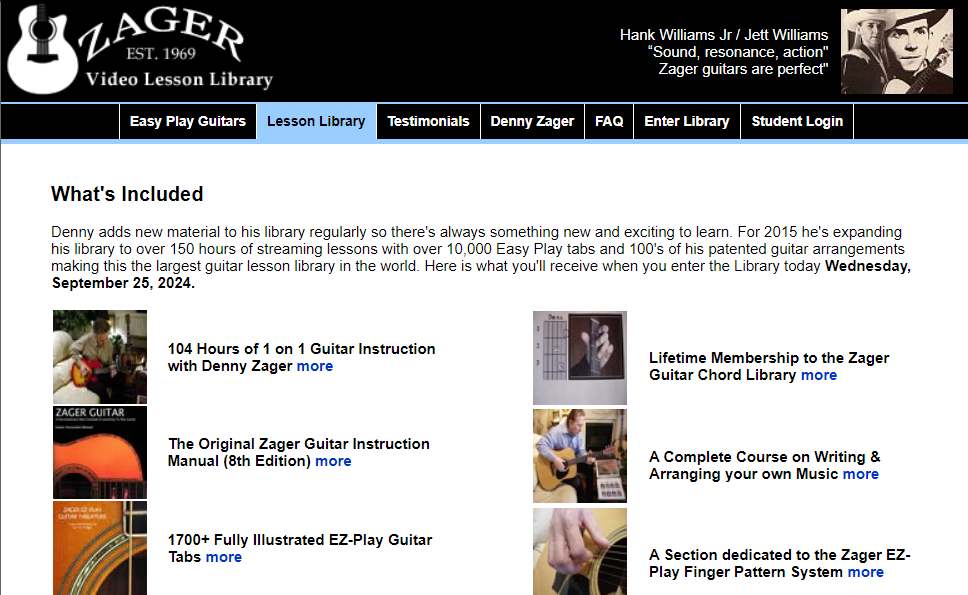
Zager has an extensive library of free guitar lessons you can access anytime. You will find basic techniques to advanced guitar learning methods from them. Most importantly, their lessons are easy to learn and well-organized. For beginners, Zagers is a great resource.
- JustinGuitar
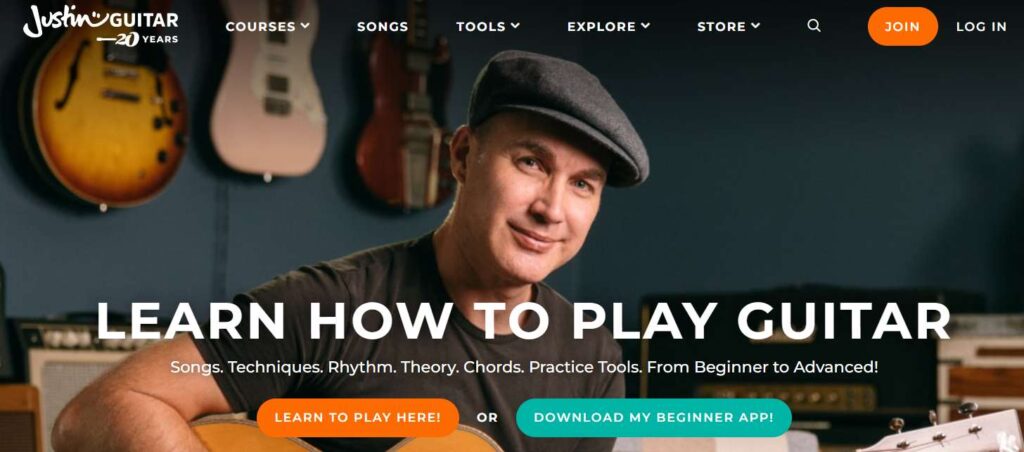
- Justinguitar is a website where you will find hundreds of free lessons. They have created a structural learning path for all levels of players. Their lessons or videos are more of a demonstration so that anyone can understand.
- Ultimate Guitar
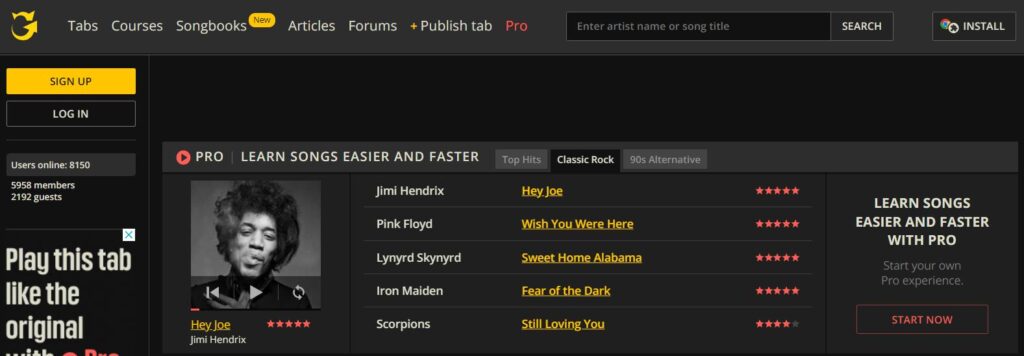
Ultimate Guitar has a wide range of free lessons and tutorials to help you understand guitar tabs and chord progressions easily. Their database is filled with a variety of topics and lead guitar techniques.
Check out Best Online Guitar Lessons: Top 10 Platforms for 2024
YouTube Channels for Learning Guitar
- Zager EZ-Play Guitars
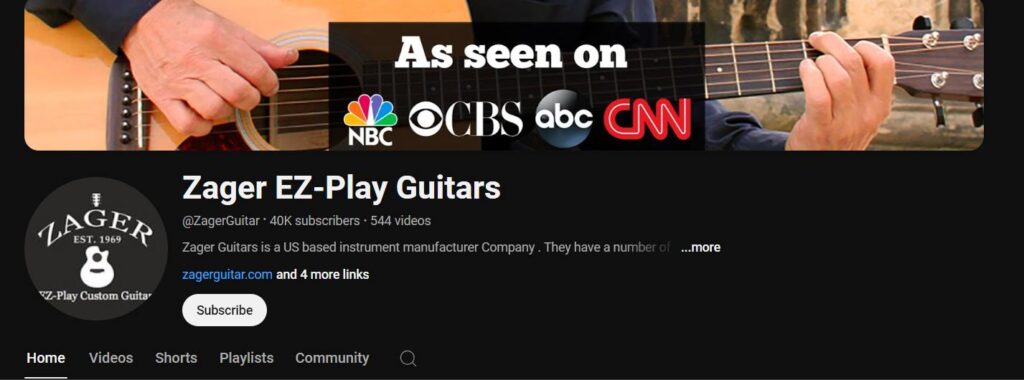
Once again, Zager guitar lessons are available on YouTube, along with a playlist of multiple ways of learning guitar. Denny Zager himself has shown how easily you can learn to play acoustic guitar. There are no complicated methods and jargon, only effortless techniques.
- Marty Music
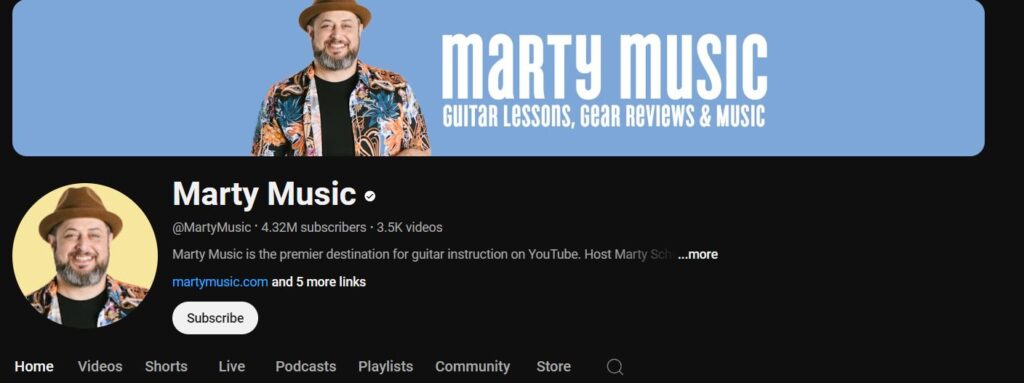
Marty Schwartz runs Marty Music’s YouTube channel. He provides clear and concise guitar lessons covering various styles and techniques. You will also learn more lessons on popular music.
Guitar Learning Apps and Tools
- Fender Play
If you are looking for a guitar learning app with interactive exercises and performance tracking, then you can download Fender Play. This app is fun and engaging, allowing you to carry out the lessons without getting bored.
- Yousician
Yousician is an interactive app that provides real-time feedback to help you learn guitar at your own pace. You can adjust your learning level; the app will give you lessons based on your skills.
When to Seek Professional Guidance?
If learning by yourself isn’t working for you. And facing these problems:
- Hitting a plateau
- Difficulty with specific techniques
- Can’t learn specific playing style
- Zero motivation and accountability
Then, it might be a sign you need external support.
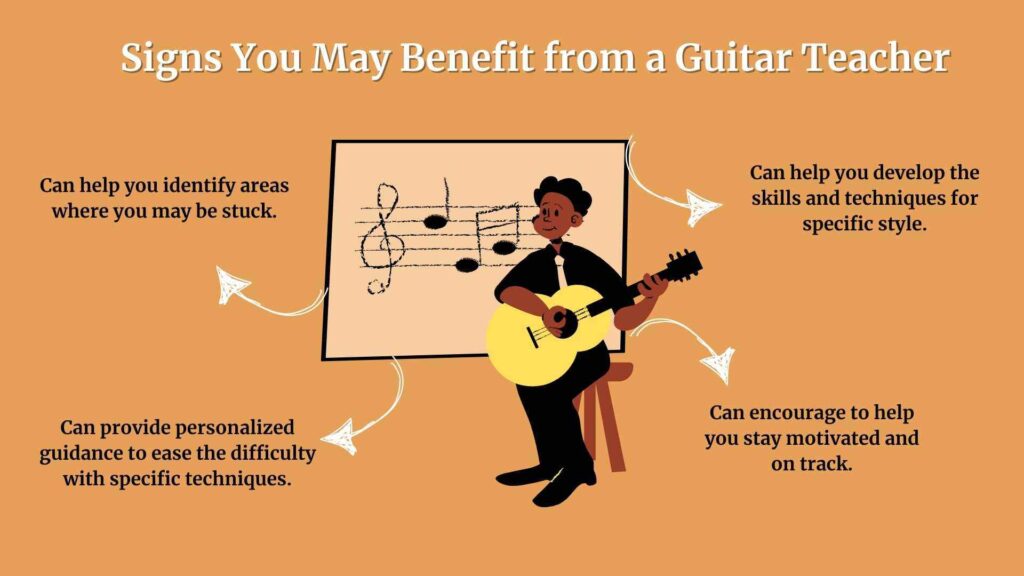
Online vs. In-Person Lessons: Which is Better?
| Features | Online Lessons | In-person Lessons |
| Flexibility | Can fit in busy schedules | Needs to schedule and commute. |
| Personalization | It can be less personalized and effective | More personalized and interactive |
| Feedback | Provide feedback but less immediate | Give real-time feedbacks |
| Cost | Generally more affordable | It can be expensive with the transportation costs as well |
Frequently Asked Question
Yes, you can. There are many online learning platforms for playing the guitar. You can easily access them from websites, YouTube, and apps.
It actually depends on your practice frequency and dedication. However, one can learn guitar mostly within several months or a year.
Learning guitar isn’t that hard compared to learning any other instrument. Guitars are pretty much easy to learn. But, like any other skill, it requires practice and patience.
An acoustic guitar with nylon strings is the easiest guitar for beginners to learn. It is softer on fingers and easier to press down.
